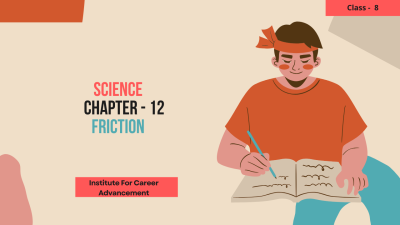Course description
1. Introduction to Friction:
Definition: Friction is the resistance force that opposes the relative motion or tendency of motion between two surfaces in contact.
Types of Friction: Students learn about static friction (when surfaces are at rest), kinetic friction (when surfaces are in motion), and rolling friction (when one object rolls over another).
2. Factors Affecting Friction:
Surface Roughness: The rougher the surface, the greater the friction.
Applied Force: The force applied between surfaces affects the frictional force.
Nature of Surfaces: Different materials have different coefficients of friction, influencing how much friction is present.
3. Laws of Friction:
Amontons' Laws: Students study the laws that describe the relationship between the frictional force, normal force (force perpendicular to the surfaces), and coefficient of friction.
Practical Examples: Understanding how friction affects everyday activities such as walking, driving, braking, and gripping objects.
4. Applications of Friction:
Beneficial Uses: Exploring how friction is beneficial in activities like walking, writing, and holding objects.
Drawbacks: Discussing how friction can cause wear and tear, reduce efficiency in machines, and be a limiting factor in certain applications.
5. Reducing Friction:
Methods: Students learn about methods to reduce friction, such as lubrication, polishing surfaces, and using ball bearings.
6. Practical Demonstrations and Experiments:
Hands-on Activities: Engaging in experiments to measure coefficients of friction, demonstrate the effects of different surfaces, and understand how friction impacts motion and stability.
7. Real-life Examples:
Engineering and Design: Understanding how engineers use knowledge of friction to design effective brakes, tires, and other mechanical systems.
1টি। ঘর্ষণের পরিচিতিঃ সংজ্ঞাঃ ঘর্ষণ হল প্রতিরোধ শক্তি যা সংস্পর্শে থাকা দুটি পৃষ্ঠের মধ্যে আপেক্ষিক গতি বা গতির প্রবণতার বিরোধিতা করে।
ঘর্ষণের প্রকারঃ শিক্ষার্থীরা স্থির ঘর্ষণ (যখন পৃষ্ঠগুলি বিশ্রামে থাকে), গতিময় ঘর্ষণ (যখন পৃষ্ঠগুলি গতিশীল থাকে) এবং ঘূর্ণায়মান ঘর্ষণ সম্পর্কে শেখে। (when one object rolls over another).
2. ঘর্ষণকে প্রভাবিত করে এমন কারণগুলিঃ
পৃষ্ঠের রুক্ষতাঃ পৃষ্ঠ যত রুক্ষ হবে, ঘর্ষণ তত বেশি হবে।
প্রয়োগ বলঃ পৃষ্ঠের মধ্যে প্রয়োগ করা বল ঘর্ষণ বলকে প্রভাবিত করে।
পৃষ্ঠতলের প্রকৃতিঃ বিভিন্ন পদার্থের ঘর্ষণের বিভিন্ন সহগ রয়েছে, যা কতটা ঘর্ষণ উপস্থিত রয়েছে তা প্রভাবিত করে।
3. ঘর্ষণের আইনঃ আমন্টনের আইনঃ শিক্ষার্থীরা ঘর্ষণ বল, স্বাভাবিক বল (পৃষ্ঠের লম্ব বল) এবং ঘর্ষণের সহগের মধ্যে সম্পর্ক বর্ণনা করে এমন নিয়মগুলি অধ্যয়ন করে।
ব্যবহারিক উদাহরণঃ কীভাবে ঘর্ষণ দৈনন্দিন ক্রিয়াকলাপ যেমন হাঁটা, গাড়ি চালানো, ব্রেকিং এবং গ্রিপিং বস্তুগুলিকে প্রভাবিত করে তা বোঝা।
4. ঘর্ষণের প্রয়োগঃ উপকারী ব্যবহারঃ হাঁটা, লেখা এবং বস্তু ধরার মতো ক্রিয়াকলাপে ঘর্ষণ কীভাবে উপকারী তা অন্বেষণ করা।
ত্রুটিগুলিঃ ঘর্ষণ কীভাবে ক্ষয়-ক্ষয়ের কারণ হতে পারে, মেশিনে দক্ষতা হ্রাস করতে পারে এবং নির্দিষ্ট প্রয়োগগুলিতে একটি সীমাবদ্ধ কারণ হতে পারে তা নিয়ে আলোচনা করা।
5. ঘর্ষণ হ্রাস করার পদ্ধতিঃ শিক্ষার্থীরা ঘর্ষণ হ্রাস করার পদ্ধতিগুলি সম্পর্কে শেখে, যেমন তৈলাক্তকরণ, পৃষ্ঠগুলি মসৃণ করা এবং বল বিয়ারিং ব্যবহার করা।
6টি। ব্যবহারিক প্রদর্শন এবং পরীক্ষা-নিরীক্ষাঃ হাতে-কলমে ক্রিয়াকলাপঃ ঘর্ষণের সহগগুলি পরিমাপ করতে, বিভিন্ন পৃষ্ঠের প্রভাবগুলি প্রদর্শন করতে এবং ঘর্ষণ কীভাবে গতি এবং স্থিতিশীলতাকে প্রভাবিত করে তা বোঝার জন্য পরীক্ষায় জড়িত হওয়া।
7. বাস্তব জীবনের উদাহরণঃ প্রকৌশল ও নকশা কার্যকর ব্রেক, টায়ার এবং অন্যান্য যান্ত্রিক ব্যবস্থার নকশা তৈরি করতে প্রকৌশলীরা কীভাবে ঘর্ষণের জ্ঞান ব্যবহার করেন তা বোঝা।



















